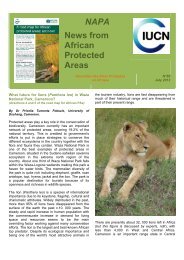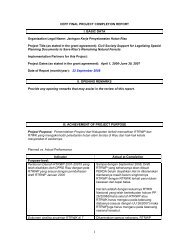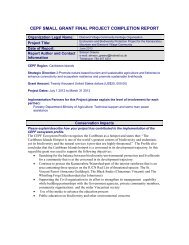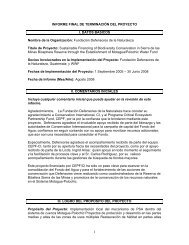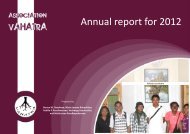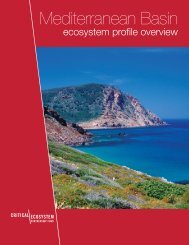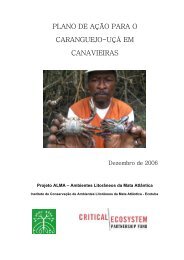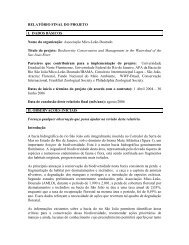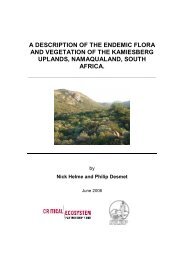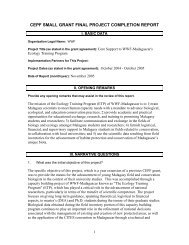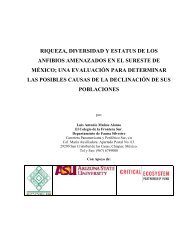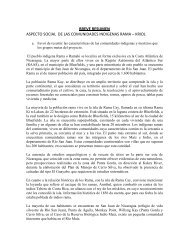English - Critical Ecosystem Partnership Fund
English - Critical Ecosystem Partnership Fund
English - Critical Ecosystem Partnership Fund
You also want an ePaper? Increase the reach of your titles
YUMPU automatically turns print PDFs into web optimized ePapers that Google loves.
Institut de Recherche et de Vulgarisation de l’Aulacodiculture en Guinée (IVRAG) –. The<br />
government institution in charge of cane rat farming in Guinea and which is providing the<br />
breeding stocks and start up supervision.<br />
The project also engaged with other ministerial departments such as the Ministry of Agriculture<br />
and the Ministry of Animal Husbandry at local level. Such local level engagement is important to<br />
catalyze technical support for the CBOs and will perhaps, in the long term, encourage<br />
government investments in post-project activities.<br />
Conservation Impacts<br />
Please explain/describe how your project has contributed to the implementation of the<br />
CEPF ecosystem profile.<br />
An important area in the implementation of the CEPF profile in the Upper Guinean Forest of the<br />
Guinean Forests of the West Africa Biodiversity Hotspot is the contribution to the alleviation of<br />
ecosystem degradation especially the effects of mineral extraction, hunting and overharvesting of<br />
biodiversity resources partly due to Limited Local Capacity for Conservation. This project<br />
specifically focused on the conservation of wildlife using an integrated approach that entailed<br />
understanding the dynamics of hunting in critical habitats and designing and implementing<br />
replicable alternative models to these practices. Unlike other initiatives where building the local<br />
conservation capacity usually consists in training and equipping government rangers especially in<br />
classical protected area management approach, the project has used a bottom up approach. In<br />
Liberia the project has established a clear understanding of the socio-economic drivers of the<br />
bushmeat trade in the southeast of Liberia and its integration into the local livelihood strategies,<br />
providing a sound basis for developing a relevant and sustainable approach to addressing<br />
overhunting in the area. In Nimba the project has worked with local hunters and the bushmeat<br />
traders to design and implement alternative source of proteins and income for all concerned. One<br />
of the most important achievements at Nimba is the establishment of baseline biological and<br />
socio-economic for long term impact monitoring. By tracking and follow trends in wildlife both at<br />
market and forest level, and also by ascertaining the impact of alternative livelihood investments<br />
on people’s wellbeing, it is possible to adjust and refine the strategy with time.<br />
Please summarize the overall results/impact of your project.<br />
A vastly improved understanding of temporal and spatial bushmeat hunting practices in and<br />
around Sapo national park has helped in the development of a bushmeat trade monitoring<br />
framework currently being implemented by the Forestry Development Authority, the mandated<br />
authority for this work in Liberia. FFI are continuing to work alongside the FDA to support both the<br />
long-term biomonitoring program and, to a lesser extent, the law-enforcement program,<br />
supporting future analysis of program efficacy.<br />
In Guinea, the project built on existing CBOs and drew the necessary lessons for consolidation<br />
and scaling up of the initiative to other important localities around the Nimba Mountains. In<br />
addition to constructing and equipping cane rat farming and fish farming facilities in the selected<br />
localities mainly Lola, Bossou, Gbakore, Zouguepo, N’Zoo and Tounkarata, the project has<br />
established and strengthened the capacity of the relevant CBOs to function dependently with<br />
minimal external support. Extending the investment to sustainable agriculture has helped to put in<br />
place a mechanism to reduce encroachment on wildlife habitats and maintain key ecological<br />
functions and processes on Nimba. Monitoring and assessing the key ecological and socioeconomic<br />
indicators will facilitate adaptive management for the long sustainable use of key<br />
resources in this key important biodiversity area of the Upper Guinean forest.



